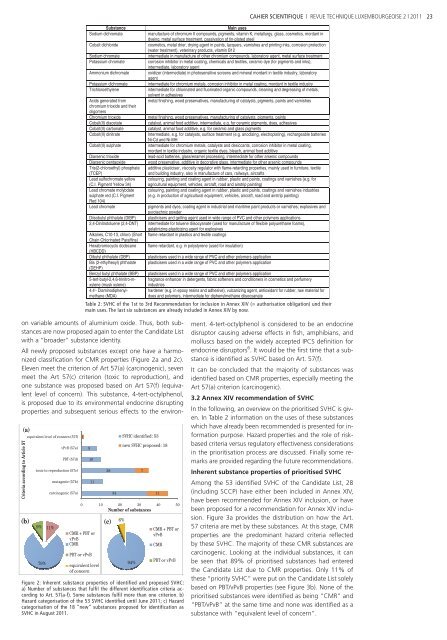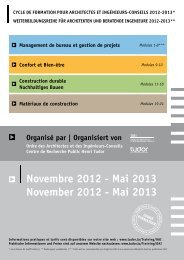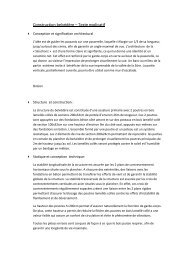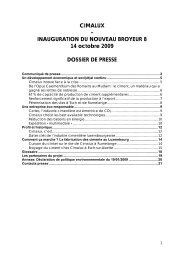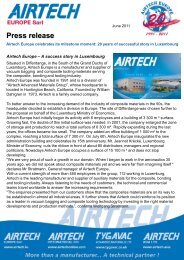Cahier Scientifique 02 | 2011 (PDF) - Revue Technique ...
Cahier Scientifique 02 | 2011 (PDF) - Revue Technique ...
Cahier Scientifique 02 | 2011 (PDF) - Revue Technique ...
Create successful ePaper yourself
Turn your PDF publications into a flip-book with our unique Google optimized e-Paper software.
CAHIER SCIENTIFIQUE | REVUE TECHNIQUE LUXEMBOURGEOISE 2 | <strong>2011</strong><br />
23<br />
Substance<br />
Sodium dichromate<br />
Cobalt dichloride<br />
Sodium chromate<br />
Potassium chromate<br />
Ammonium dichromate<br />
Potassium dichromate<br />
Trichloroethylene<br />
Acids generated from<br />
chromium trioxide and their<br />
oligomers<br />
Chromium trioxide<br />
Cobalt(II) diacetate<br />
Cobalt(II) carbonate<br />
Cobalt(II) dinitrate<br />
Cobalt(II) sulphate<br />
Diarsenic trioxide<br />
Diarsenic pentaoxide<br />
Tris(2-chloroethyl) phosphate<br />
(TCEP)<br />
Lead sulfochromate yellow<br />
(C.I. Pigment Yellow 34)<br />
Lead chromate molybdate<br />
sulphate red (C.I. Pigment<br />
Red 104)<br />
Lead chromate<br />
Diisobutyl phthalate (DIBP)<br />
2,4-Dinitrotoluene (2,4-DNT)<br />
Alkanes, C10-13, chloro (Short<br />
Chain Chlorinated Paraffins)<br />
Hexabromocyclo dodecane<br />
(HBCDD)<br />
Dibutyl phthalate (DBP)<br />
Bis (2-ethylhexyl) phthalate<br />
(DEHP)<br />
Benzyl butyl phthalate (BBP)<br />
5-tert-butyl-2,4,6-trinitro-mxylene<br />
(musk xylene)<br />
4,4'- Diaminodiphenylmethane<br />
(MDA)<br />
Main uses<br />
manufacture of chromium II compounds, pigments, vitamin K, metallurgy, glass, cosmetics, mordant in<br />
dyeing, metal surface treatment, passivation of tin-plated steel<br />
cosmetics, metal drier, drying agent in paints, lacquers, varnishes and printing inks, corrosion protection<br />
(water treatment), veterinary products, vitamin B12<br />
intermediate in manufacture of other chromium compounds, laboratory agent, metal surface treatment<br />
corrosion inhibitor in metal coating, chemicals and textiles, ceramic dye (for pigments and inks),<br />
intermediate, laboratory agent<br />
oxidizer (intermediate) in photosensitive screens and mineral mordant in textile industry, laboratory<br />
agent<br />
intermediate for chromium metals, corrosion inhibitor in metal coating, mordant in textile industry<br />
intermediate for chlorinated and fluorinated organic compounds, cleaning and degreasing of metals,<br />
solvent in adhesives<br />
metal finishing, wood preservatives, manufacturing of catalysts, pigments, paints and varnishes<br />
metal finishing, wood preservatives, manufacturing of catalysts, pigments, paints<br />
catalyst, animal food additive, intermediate, e.g. for ceramic pigments, dyes, adhesives<br />
catalyst, animal food additive, e.g. for ceramic and glass pigments<br />
Intermediate, e.g. for catalysts, surface treatment (e.g. anodizing, electroplating), rechargeable batteries<br />
Ni-Cd and Ni-MH<br />
intermediate for chromium metals, catalysts and desiccants, corrosion inhibitor in metal coating,<br />
mordant in textile industry, organic textile dyes, bleach, animal food additive<br />
lead-acid batteries, glass/enamel processing, intermediate for other arsenic compounds<br />
wood preservative, additive in decorative glass, intermediate for other arsenic compounds<br />
additive plasticiser, viscosity regulator with flame-retarding properties, mainly used in furniture, textile<br />
and building industry, also in manufacture of cars, railways, aircrafts<br />
colouring, painting and coating agent in rubber, plastic and paints, coatings and varnishes (e.g. for<br />
agricultural equipment, vehicles, aircraft, road and airstrip painting)<br />
colouring, painting and coating agent in rubber, plastic and paints, coatings and varnishes industries<br />
(e.g. in production of agricultural equipment, vehicles, aircraft, road and airstrip painting)<br />
pigments and dyes, coating agent in industrial and maritime paint products or varnishes; explosives and<br />
pyrotechnic powder<br />
plasticisers and gelling agent used in wide range of PVC and other polymers applications<br />
intermediate for toluene diisocyanate (used for manufacture of flexible polyurethane foams),<br />
gelatinizing-plasticizing agent for explosives<br />
flame retardant in plastics and textile coatings<br />
flame retardant, e.g. in polystyrene (used for insulation)<br />
plasticisers used in a wide range of PVC and other polymers application<br />
plasticisers used in a wide range of PVC and other polymers application<br />
plasticisers used in a wide range of PVC and other polymers application<br />
fragrance enhancer in detergents, fabric softeners and conditioners in cosmetics and perfumery<br />
industries<br />
hardener (e.g. in epoxy resins and adhesive), vulcanizing agent, antioxidant for rubber, raw material for<br />
dyes and polymers, intermediate for diphenylmethane diisocyanate<br />
Table 2: SVHC of the 1st to 3rd Recommendation for inclusion in Annex XIV (= authorisation obligation) und their<br />
main uses. The last six substances are already included in Annex XIV by now.<br />
CriteriaaccordingtoArticle57<br />
(a)<br />
(b)<br />
equivalentlevelofconcern(57f)<br />
toxictoreproduction(57c)<br />
9%<br />
79%<br />
carcinogenic(57a)<br />
11%<br />
vPvB(57e)<br />
PBT(57d)<br />
mutagenic(57b)<br />
1<br />
8<br />
10<br />
11<br />
28<br />
34<br />
SVHCidentified:53<br />
newSVHCproposed:18<br />
0 10 20 30 40 50<br />
Numberofsubstances<br />
CMR+PBTor<br />
vPvB<br />
CMR<br />
PBTorvPvB<br />
equivalentlevel<br />
ofconcern<br />
(c)<br />
6%<br />
94%<br />
7<br />
11<br />
CMR+PBTor<br />
vPvB<br />
CMR<br />
PBTorvPvB<br />
Figure 2: Inherent substance properties of identified and proposed SVHC:<br />
a) Number of substances that fulfil the different identification criteria according<br />
to Art. 57(a-f). Some substances fulfil more than one criterion. b)<br />
Hazard categorisation of the 53 SVHC identified until June <strong>2011</strong>; c) Hazard<br />
categorisation of the 18 “new” substances proposed for identification as<br />
SVHC in August <strong>2011</strong>.<br />
on variable amounts of aluminium oxide. Thus, both substances<br />
are now proposed again to enter the Candidate List<br />
with a “broader” substance identity.<br />
All newly proposed substances except one have a harmonized<br />
classification for CMR properties (Figure 2a and 2c).<br />
Eleven meet the criterion of Art 57(a) (carcinogenic), seven<br />
meet the Art 57(c) criterion (toxic to reproduction), and<br />
one substance was proposed based on Art 57(f) (equivalent<br />
level of concern). This substance, 4-tert-octylphenol,<br />
is proposed due to its environmental endocrine disrupting<br />
properties and subsequent serious effects to the environment.<br />
4-tert-octylphenol is considered to be an endocrine<br />
disruptor causing adverse effects in fish, amphibians, and<br />
molluscs based on the widely accepted IPCS definition for<br />
endocrine disruptors 6 . It would be the first time that a substance<br />
is identified as SVHC based on Art. 57(f).<br />
It can be concluded that the majority of substances was<br />
identified based on CMR properties, especially meeting the<br />
Art 57(a) criterion (carcinogenic).<br />
3.2 Annex XIV recommendation of SVHC<br />
In the following, an overview on the prioritised SVHC is given.<br />
In Table 2 information on the uses of these substances<br />
which have already been recommended is presented for information<br />
purpose. Hazard properties and the role of riskbased<br />
criteria versus regulatory effectiveness considerations<br />
in the prioritisation process are discussed. Finally some remarks<br />
are provided regarding the future recommendations.<br />
Inherent substance properties of prioritised SVHC<br />
Among the 53 identified SVHC of the Candidate List, 28<br />
(including SCCP) have either been included in Annex XIV,<br />
have been recommended for Annex XIV inclusion, or have<br />
been proposed for a recommendation for Annex XIV inclusion.<br />
Figure 3a provides the distribution on how the Art.<br />
57 criteria are met by these substances. At this stage, CMR<br />
properties are the predominant hazard criteria reflected<br />
by these SVHC. The majority of these CMR substances are<br />
carcinogenic. Looking at the individual substances, it can<br />
be seen that 89% of prioritised substances had entered<br />
the Candidate List due to CMR properties. Only 11% of<br />
these “priority SVHC” were put on the Candidate List solely<br />
based on PBT/vPvB properties (see Figure 3b). None of the<br />
prioritised substances were identified as being “CMR” and<br />
“PBT/vPvB” at the same time and none was identified as a<br />
substance with “equivalent level of concern”.


